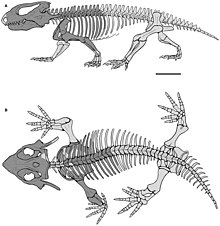Procolophonidae
| Procolophonids Temporal range:
Middle Permian-Late Triassic
| |
|---|---|

| |

| |
| Skeleton (top) and life restoration (bottom) ofKapes bentoni(Procolophoninae) scale bar = 1cm | |
| Scientific classification | |
| Domain: | Eukaryota |
| Kingdom: | Animalia |
| Phylum: | Chordata |
| Class: | Reptilia |
| Clade: | †Parareptilia |
| Order: | †Procolophonomorpha |
| Superfamily: | †Procolophonoidea |
| Family: | †Procolophonidae Seeley,1888 |
| Subgroups and Genera | |
| Synonyms | |

Procolophonidaeis an extinctfamilyof small, lizard-likeparareptilesknown from theLate PermiantoLate Triassicthat were distributed acrossPangaea,having been reported from Europe, North America, China, South Africa, South America, Antarctica and Australia. The most primitive procolophonids were likely insectiovous or omnivorous, morederivedmembers of the clade developedbicuspedmolars, and were likely herbivorous feeding on high fiber vegetation ordurophagousomnivores.[3]Many members of the group are noted for spines projecting from thequadratojugal boneof the skull, which likely served a defensive purpose as well as possibly also for display.[4]At least some taxa were likelyfossorialburrowers.[5]While diverse during the Early and Middle Triassic, they had very low diversity during the Late Triassic, and were extinct by the beginning of theJurassic.[6]
Phylogeny
[edit]Below is acladogramfrom Rutaet al.(2011):[7]
| Procolophonidae | |
Below are three cladograms that followphylogenetic analysesby Butleret al.(2023).Analysis 1:Strict consensus of 760most parsimonious trees(MPTs):[8]
| Procolophonidae |
| ||||||||||||||||||||||||||||||||||||||||||||||||||||||
Analysis 2:Single MPT:[8]
| Procolophonidae |
| ||||||||||||||||||||||||||||||||||||||||||||||||
Analysis 3:Strict consensus of 18 MPTs:[8]
| Procolophonidae |
| ||||||||||||||||||||||||||||||||||||||||||
References
[edit]- ^Cisneros, J. C. (2008). "Phylogenetic relationships of procolophonid parareptiles with remarks on their geological record".Journal of Systematic Palaeontology.6(3): 345–366.Bibcode:2008JSPal...6..345C.doi:10.1017/S1477201907002350.S2CID84468714.
- ^Hans-Dieter Sues and Robert R. Reisz (2008). "Anatomy and Phylogenetic Relationships ofSclerosaurus armatus(Amniota: Parareptilia) from the Buntsandstein (Triassic) of Europe ".Journal of Vertebrate Paleontology.28(4): 1031–1042.Bibcode:2008JVPal..28.1031S.doi:10.1671/0272-4634-28.4.1031.S2CID53967912.
- ^Pinheiro, Felipe L.; Silva-Neves, Eduardo; Da-Rosa, Átila A. S. (August 2021). Ruta, Marcello (ed.)."An early-diverging procolophonid from the lowermost Triassic of South America and the origins of herbivory in Procolophonoidea".Papers in Palaeontology.7(3): 1601–1612.Bibcode:2021PPal....7.1601P.doi:10.1002/spp2.1355.ISSN2056-2799.S2CID233797716.
- ^Zaher, Marta; Coram, Robert A.; Benton, Michael J. (February 2019). Angielczyk, Kenneth (ed.)."The Middle Triassic procolophonid Kapes bentoni: computed tomography of the skull and skeleton".Papers in Palaeontology.5(1): 111–138.Bibcode:2019PPal....5..111Z.doi:10.1002/spp2.1232.hdl:1983/3dd2d71d-a439-404a-997f-758063f40678.S2CID134058607.
- ^Botha-Brink, Jennifer; Smith, Roger Malcolm Harris (September 2012)."Palaeobiology of Triassic procolophonids, inferred from bone microstructure".Comptes Rendus Palevol.11(6): 419–433.Bibcode:2012CRPal..11..419B.doi:10.1016/j.crpv.2012.03.002.
- ^MacDougall, Mark J.; Brocklehurst, Neil; Fröbisch, Jörg (2019-03-20)."Species richness and disparity of parareptiles across the end-Permian mass extinction".Proceedings of the Royal Society B: Biological Sciences.286(1899): 20182572.doi:10.1098/rspb.2018.2572.ISSN0962-8452.PMC6452079.PMID30890099.
- ^Ruta, M.; Cisneros, J. C.; Liebrecht, T.; Tsuji, L. A.; Müller, J. (2011)."Amniotes through major biological crises: Faunal turnover among Parareptiles and the end-Permian mass extinction".Palaeontology.54(5): 1117–1137.Bibcode:2011Palgy..54.1117R.doi:10.1111/j.1475-4983.2011.01051.x.S2CID83693335.
- ^abcButler, R. J.; Meade, L. E.; Cleary, T. J.; McWhirter, K. T.; Brown, E. E.; Kemp, T. S.; Benito, J.; Fraser, N. C. (2023)."Hwiccewyrm trispiculumgen. et sp. nov., a new leptopleuronine procolophonid from the Late Triassic of southwest England ".The Anatomical Record.doi:10.1002/ar.25316.PMID37735997.
Sources
[edit]- Lambert, David (2001).Dinosaur Encyclopedia.New York: Dorling Kindersley. p.72.ISBN9780789479358.
External links
[edit]


